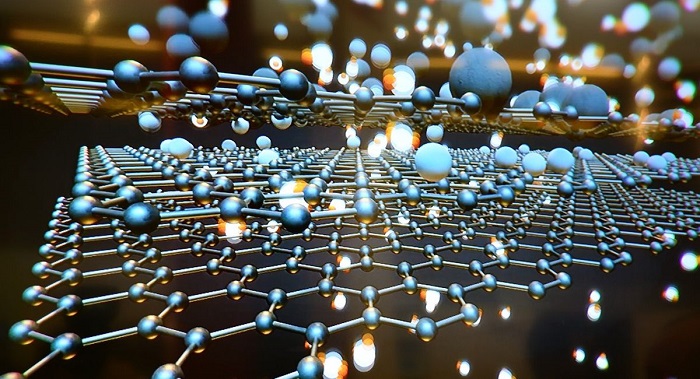PABLO GARCÍA-RUBIO | Tungsteno
From the pyramids of Egypt to the Burj Khalifa, the great structures erected by humans have reflected the progress and technological evolution of humanity. However, some of the greatest scientific achievements of the last two decades—with the potential to shape our society during this century—have actually occurred in a field that works on an infinitely smaller scale: the nanometre. Can nanotechnology become the engine powering a new industrial revolution?
Nanotechnology encompasses any manipulation or application of matter at the nanometric scale for the development of solutions, materials or devices with possibilities that border on science fiction. While we await the definitive explosion of this technology in the coming decades, some of its applications are already being seen in certain sectors, especially those related to the development of materials.
Supermaterials and construction, the biggest breakthroughs
The manipulation of materials at the nanometre-scale can change their properties in a revolutionary way. Thanks to the ability to modify matter at such a minute level, a material can be made lighter, stronger, water repellent or more electrically conductive.
Construction is one of the sectors that has benefited most from advances in nanotechnology which can be used to make building materials that are stronger, more efficient and more durable. By adding compounds based on titanium oxide, aluminium or zinc, surfaces can be made resistant to water, corrosion or ultraviolet radiation. The Jubilee Church in Rome is a good example. Its white concrete structure was coated with a nanostructured titanium oxide-based compound that protects its surface from external elements such as pollution and weathering. In this way, the building retains its white colour and does not degrade over time.

The coating applied to the exterior of the Jubilee Church in Rome prevents degradation caused by pollution and weathering. Credit: Wikimedia.
The textile industry has also taken advantage of the development of nanoscale modified materials. By adding a coating to cotton fibres, companies such as NanoTex harness this ability to modify materials and design garments that are resistant to liquids and therefore more durable. Another example is the development of the LZR Racer swimsuit by Speedo, which uses nanoparticles to reduce the absorption of water from its surface with the intention of minimising swimmer friction and increasing swimming speed. The swimsuit in question enabled swimmers who wore it to break 46 world records until the International Swimming Federation banned it as "technological doping".
Nanostructured coatings can also be applied to packaging to repel the product inside. This is how a bottle of ketchup or shampoo can be squeezed to get the very last drop, as the contents don’t stick to the walls of the plastic container. This avoids wasting between 5% and 20% of the product. "If you think about just a single bottle, it would seem not a big deal, but if you think about billions of bottles, then it all adds up and it can make a huge difference," says Sushant Anand, an engineer at the University of Illinois who developed one of these coatings.
Nanostructured coating technology on packaging prevents 5%-20% of the product from being discarded. Credit: Massachusetts Institute of Technology.
The potential of nanotechnology does not end there. Virtually every electronic device we use today has benefited from the ability to modify elements at the nanoscale. Electronics moved from "micro" to "nano" years ago, with the ability to make processors ever smaller and more powerful. As a result, 30 billion nanometric transistors can now be packed into a one square centimetre chip.
Nanotechnology: revolution or gimmick?
Beyond nanoelectronics, the application of nanotechnology in consumer products has been rather limited. However, the use of the term "nano" as a marketing ploy has been used for years in sectors such as cosmetics, cleaning materials and sports equipment. On many occasions its apparent revolutionary transformative capacity goes no further than marketing gimmickry.
"Some products claim to contain nanoparticles and it is likely that they do, but the capacity of these nanoparticles to make the product into something completely different from what it was before is limited," says Agustín Camón, a researcher at the Institute of Nanoscience and Materials of Aragón. For example, "a product may contain graphene, but no product on the market currently benefits from the qualities of graphene."
While nanotechnology has served to develop and enhance the capabilities of some products, so far none of them have significantly revolutionised their sector. They are just the tip of the iceberg compared to the applications that nanotechnology has the potential to deliver in the coming decades.

Thanks to nanotechnology, it is possible to make a material water-repellent. Credit: Pexels.
"Nanotechnology is no scam. There is a huge amount of research and investment going on," explains Camón. The expert asserts that "there are a lot of applications being developed that would otherwise be impossible to carry out. It’s a technology that is giving very good results and will do so in the future."
Researchers around the world are developing new technologies with enormous potential that could, in the near future, leave the laboratory and be applied in the real world, from cancer therapies able to attack individual malignant cells without affecting the rest of the body, to nanosensors that could identify pathogens in a potential biological war. In addition, the future of nanotechnology lies in driving the development of the abundant applications of graphene and carbon nanotubes and improving the efficiency and storage of renewable energy.
While all these applications are making their way into our lives, this "invisible revolution" is already slowly taking shape in laboratories and research centres across the globe, with the prospect of changing everything we know.
· — —
Tungsteno is a journalism laboratory to scan the essence of innovation. Devised by Materia Publicaciones Científicas for Sacyr’s blog.
